Setting Sail With Confidence: Your Essential Boating Safety Guide
Boating offers a wonderful sense of freedom, connecting us with the open water. But the water can be unpredictable, making safety a top priority for every trip. From preventing fuel spills that harm marine life to ensuring quick communication in emergencies, the right safety equipment can make all the difference. This guide explores seven essential tools and technologies that every responsible boat owner, fleet captain, marina operator, and boating enthusiast should be familiar with.
Choosing the right safety gear isn't as simple as grabbing the first thing you see. Factors like US Coast Guard approvals, durability in harsh marine environments, and ease of use in stressful situations are critical. Integration with other onboard systems can also be a key consideration. We'll explore these factors, discuss pricing and technical aspects, and help you make informed decisions about the tools that will best protect you, your passengers, and our waterways.
Essential Safety Equipment Checklist
- Life Jackets: Ensure you have enough properly fitted life jackets for everyone on board.
- Visual Distress Signals: Flares and signal flags can help rescuers locate you in an emergency.
- Sound-Producing Devices: A whistle or air horn is crucial for signaling for help.
- Fire Extinguishers: Have the correct type and size for your boat and ensure they are readily accessible.
- Navigation Lights: Properly functioning navigation lights are essential for safe boating at night.
- Marine Radio: A VHF radio allows for communication with other boats and the Coast Guard.
- Emergency Position Indicating Radio Beacon (EPIRB): An EPIRB can pinpoint your location in a life-threatening emergency.
Understanding Key Considerations
When choosing safety equipment, look for US Coast Guard approval to ensure it meets required standards. Consider the materials and construction to ensure durability in the harsh marine environment. Equipment should also be easy to use under pressure. Think about how the equipment will integrate with your existing onboard systems.
By the end of this guide, you'll have a solid understanding of essential boating safety equipment and be ready to set sail with confidence, knowing you're prepared for any challenges the water may bring.
1. CLiX Fueling Solutions
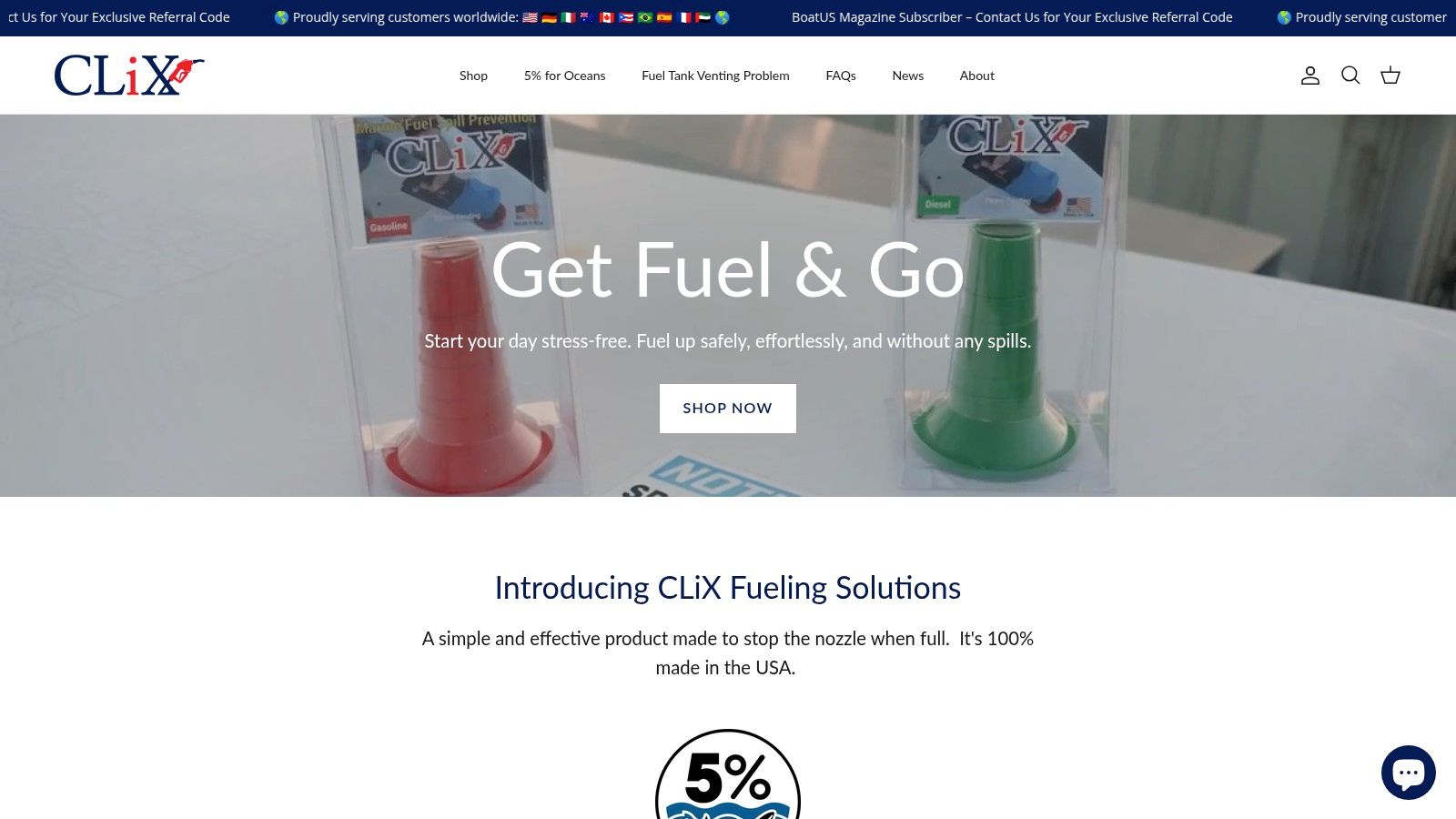
CLiX Fueling Solutions makes this boating safety equipment list for a good reason: it tackles fuel management. Spilled fuel isn't just a mess; it's a serious safety risk that could lead to fires or explosions. It’s also harmful to our marine environments. CLiX offers a solution with its spill-free fueling system.
Imagine fueling your boat without the stress of spills. The CLiX system automatically stops the fuel flow when the tank is full. This prevents costly and environmentally damaging spills. This technology protects your boat, your wallet, and our waterways. Whether you’re a weekend boater or manage a fleet, CLiX offers improved safety and efficiency. Marinas can also benefit from a cleaner, safer environment for their customers.
CLiX is made in the USA and comes in both diesel and gas models for various boat types. It's designed for simple installation and easy use. The system has earned positive reviews from both professional captains and recreational boaters, highlighting its reliability. Check out the CLiX Products Sitemap for specific product information.
Pros:
- Prevents overfilling and spills by automatically stopping fuel flow
- Protects your boat and minimizes environmental damage
- Available for both diesel and gas engines, made in the USA
- Positively reviewed by experienced boaters and captains
- User-friendly design
Cons:
- Primarily focused on boat fueling, limiting other applications
- Pricing requires direct contact with the company
While CLiX's current focus is boating, the spill-prevention technology could be useful in other industries. For now, they're committed to boating safety and sustainability. For pricing information, visit the CLiX Fueling Solutions website.
2. United States Coast Guard (USCG) Approved Personal Flotation Devices (PFDs)
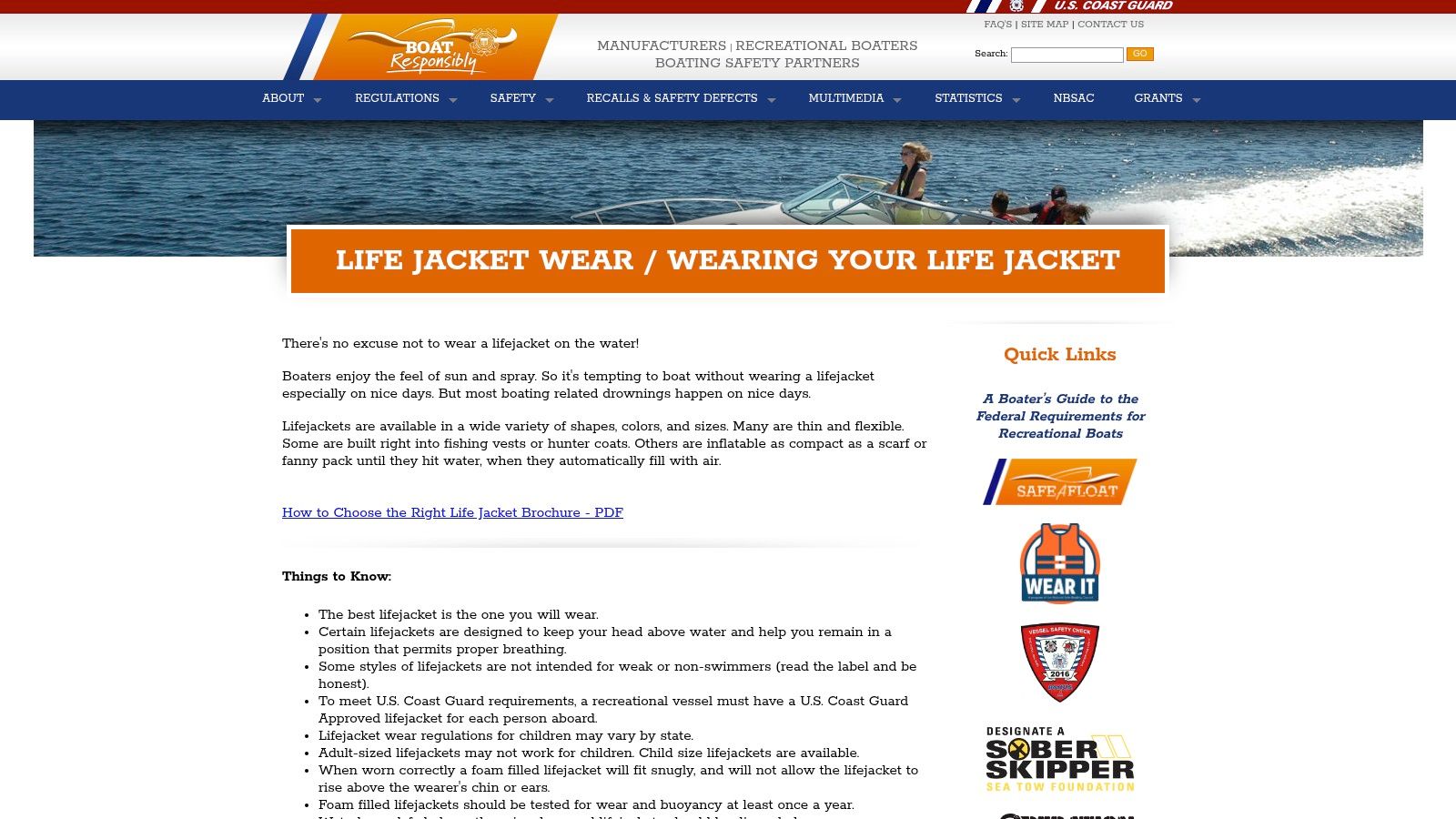
USCG-approved PFDs are essential for boating safety. They are designed to save your life in an accident or emergency. A PFD's ability to keep someone afloat can be the difference between a close call and a tragedy. This makes them vital for recreational boat owners, professional captains, and anyone on a boat.
Having the right PFDs is non-negotiable.
Why Are PFDs So Important?
Federal law requires at least one correctly sized, USCG-approved PFD for each person on board. This is not just a rule, but a critical safety precaution.
Types and Uses of PFDs
PFDs are divided into Types I-V, each designed for specific activities and water conditions:
-
Type I (Offshore Life Jacket): These offer the greatest buoyancy. They're ideal for open ocean or rough waters where rescue may take time.
-
Type II (Near-Shore Buoyant Vest): Suitable for calm, inland waters where a quick rescue is likely.
-
Type III (Flotation Aid): Designed for recreational boating and supervised activities. These allow more freedom of movement and are more comfortable for extended wear than Type I or II. They’re the most common type for general boating.
-
Type IV (Throwable Device): This type includes ring buoys and cushions. They are meant to be thrown to someone in the water, not worn.
-
Type V (Special Use Device): Created for particular activities like kayaking, waterskiing, or windsurfing. They must be worn to be effective.
Features & Benefits of PFDs
PFDs offer several important features:
- Buoyancy: Keeps people afloat, even if unconscious.
- Visibility: Bright colors and reflective materials help locate people in the water.
- Inflation Options: Some PFDs inflate automatically when immersed in water, quickly providing buoyancy.
- Safety Features: Many include whistles for signaling and attachment points for lights.
- Size Specificity: Available in sizes for infants, children, and adults for a secure and effective fit.
Pros and Cons of PFDs
Let's look at the advantages and disadvantages of using PFDs:
Pros:
- Life-saving in emergencies.
- Current designs are often more comfortable and less bulky.
- Available in various sizes for everyone.
- Enhanced features like lights and whistles add to safety.
Cons:
- High-quality PFDs can cost between $30 and $200+, depending on type and features.
- They require regular inspection and maintenance, such as replacing inflatable cartridges.
- Some can be uncomfortable in hot weather, though newer designs address this.
- Bulky types might restrict movement, particularly for activities like paddling.
Tips for Using PFDs
Here's how to get the most out of your PFDs:
- Make sure everyone on board has a PFD that fits correctly.
- Keep PFDs in easy-to-reach spots.
- Show everyone on the boat how to put on and use their PFD.
- Check PFDs regularly for damage or wear.
- For inflatable PFDs, check the CO2 cartridges’ expiration dates and replace them as needed.
Investing in high-quality, properly fitted, USCG-approved PFDs is crucial for everyone's safety on the water. It's a vital piece of boating equipment you shouldn't overlook.
3. Marine VHF Radio
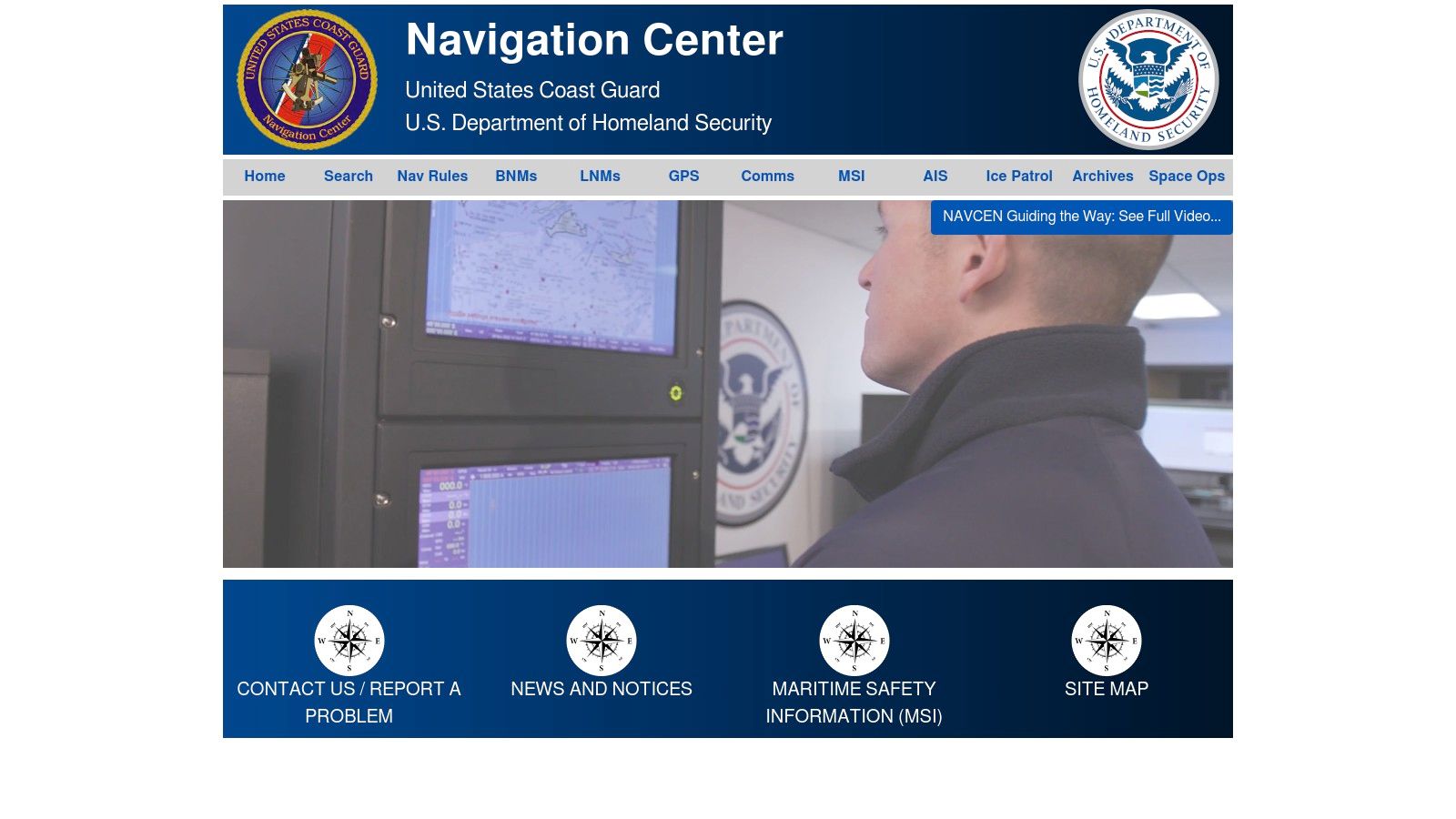
A Marine VHF radio is a vital piece of safety equipment for any boat. Unlike cell phones, which depend on land-based towers, VHF radios use radio waves. This makes them reliable even when you're miles offshore and out of cell phone range. Imagine an engine failure or sudden storm far from shore – your VHF radio could be a lifeline.
VHF radios allow you to contact the Coast Guard, nearby vessels, and marinas, ensuring help arrives quickly. They also broadcast to multiple receivers at once. This is invaluable in emergencies or when coordinating with a group of boats. From routine communication to critical weather updates, a VHF radio is essential for safe boating.
Key Features and Benefits
-
DSC (Digital Selective Calling): When linked to a GPS, DSC automatically transmits your boat's location in an emergency. This drastically speeds up rescue efforts by alerting the Coast Guard and other DSC-equipped vessels.
-
Weather Alerts: Stay informed about changing conditions with dedicated weather channels broadcasting NOAA weather reports and warnings. This helps you avoid potential hazards and make informed decisions.
-
Waterproof Construction: Built to withstand the harsh marine environment, most VHF radios have an IPX7 or IPX8 waterproof rating. This means they can handle splashes and even brief submersion.
-
GPS Connectivity: Many VHF radios integrate with or connect to GPS systems. This enhances safety features like DSC and provides valuable location data.
-
Channel 16: This is the international distress, safety, and calling channel. Monitored by the Coast Guard and other vessels, Channel 16 provides a direct line to assistance in emergencies.
Pros and Cons of Marine VHF Radios
Here's a quick overview of the advantages and disadvantages:
| Pros | Cons |
|---|---|
| Works Beyond Cell Service | Requires Radio Protocol Knowledge |
| Direct Emergency Contact | Installation (Fixed Mount) Requires Wiring |
| Real-Time Weather Updates | Range Limitations Depending on Antenna/Power |
| Multiple Dedicated Communication Channels | Licensing May Be Required for International Waters |
Implementation Tips
-
Licensing: Obtain a VHF Radio Operator's License if required for your boating area.
-
Radio Procedure: Familiarize yourself with basic radio procedures and the phonetic alphabet.
-
Testing: Regularly test your radio to ensure it's working correctly and has power.
-
Channel Programming: Program important channels, especially Channel 16, into your radio's memory.
-
Backup: Consider a handheld VHF radio as a backup for fixed-mount units.
VHF radios range in price from around $100 for basic handhelds to several hundred dollars for advanced fixed-mount units with features like integrated GPS. The peace of mind and potential life-saving capabilities make them a worthwhile investment for any boater. For more information on Marine VHF Radios and regulations, visit the US Coast Guard Navigation Center. You might also find useful information on our ClixFueling Sitemaps.
4. Visual Distress Signals (Flares and E-Flares)
When trouble hits out on the water, being visible is crucial for a swift rescue. Visual Distress Signals (VDS) are vital for alerting nearby boats or aircraft that you need help, making them a must-have on any boating safety checklist. These signals are legally required for most boats on coastal waters or the Great Lakes. Don't let a fun day turn disastrous; ensure you have the right VDS for peace of mind and the safety of everyone on board.
There are two main types of VDS:
-
Pyrotechnic Flares: These traditional flares use a bright, burning chemical reaction to signal distress. They’re highly visible, even in thick fog or smoke. They come in different forms, like handheld flares, aerial flares that shoot high into the sky, and floating flares for marking your location in the water. However, pyrotechnic flares have a short burn time (usually only a few minutes each), expire 42 months after manufacture, and require careful handling and proper disposal.
-
Electronic Visual Distress Signals (e-flares): These battery-powered devices provide a reusable and long-lasting alternative to pyrotechnic flares. E-flares usually use high-intensity LED lights, offering extended operating times. While they might be less visible than pyrotechnic flares in bright daylight, their long battery life and reusability make them a strong option. They also eliminate disposal needs and the dangers of pyrotechnics.
Features of Visual Distress Signals
- Day and Night Signaling: Both types offer day and night signaling.
- Long-Range Visibility: Flares are designed to be seen from miles away, increasing your chance of rescue.
- Variety of Types: Choose from handheld, aerial, or floating options to suit your needs.
- Long Battery Life (e-flares): Electronic flares offer extended battery life for prolonged use in emergencies.
- Waterproof Storage: Always store your flares in a waterproof and easily accessible container.
Pros and Cons
Here's a quick comparison:
| Feature | Pyrotechnic Flares | E-Flares |
|---|---|---|
| Visibility | Excellent, even in poor conditions | Good, but can be less effective in bright sunlight |
| Lifespan | Expires after 42 months | Reusable with long battery life |
| Safety | Handling hazards and disposal required | Safer handling and no disposal needed |
| Cost | Lower initial cost | Higher initial cost, but reusable |
Pricing and Setup Tips
Pyrotechnic flare kits typically cost between $30 and $100, while individual e-flares can range from $100 to $300.
- Practice using your flares before an emergency.
- Store flares in a marked, waterproof container in an easy-to-reach spot.
- Check pyrotechnic flare expiration dates and replace them as needed.
- Test e-flares regularly to ensure they work and have sufficient battery charge.
- Consider a boating safety course covering the proper use of distress signals.
For more information on USCG requirements for visual distress signals, visit: https://www.uscgboating.org/recreational-boaters/safety-equipment-requirements.php
5. Automatic Identification System (AIS)

An Automatic Identification System (AIS) significantly improves safety and situational awareness for boaters. It's a vital piece of equipment, especially in congested waterways or difficult conditions. AIS allows vessels to electronically "see" and be "seen", even in fog, darkness, or around bends. It achieves this by transmitting and receiving vessel data, including identification, position, course, and speed, to and from other AIS-equipped vessels and coastal stations.
Think of AIS as a digital "name tag" for your boat, constantly broadcasting key information to other vessels in the area. This real-time tracking simplifies collision avoidance, particularly with large commercial vessels that might be difficult to spot visually. Imagine navigating a foggy harbor. With AIS, you'll have a clear view of nearby traffic on your chartplotter, even if you can't physically see them.
Types of AIS Systems
There are two primary types of AIS systems available:
- Class A: Mandatory for most commercial vessels, Class A systems transmit data more frequently and at a higher power.
- Class B: Designed for recreational boaters, Class B systems are a cost-effective option for increased safety. They transmit less frequently and with less power than Class A systems, but still provide crucial collision avoidance capabilities.
Key Features and Benefits
- Real-time Tracking: See and be seen by other vessels in your vicinity.
- Integration: Works seamlessly with chartplotters and other navigation systems.
- Collision Warnings: Provides alerts of potential collisions.
- Vessel Data: Displays vessel name, MMSI (Maritime Mobile Service Identity), course, and speed.
- Flexible Options: Available as receive-only (AIS receiver) or transceiver (transmit and receive) units.
Pros of Using AIS
- Enhanced Awareness: Improves navigational awareness, especially in busy or low-visibility conditions.
- Collision Prevention: Helps avoid collisions, particularly with commercial traffic.
- Early Warning: Gives advance notice of approaching vessels.
- Works in All Conditions: Operates effectively in fog, darkness, and other situations with reduced visibility.
Cons of Using AIS
- Cost: AIS equipment can be more expensive than basic safety gear. AIS receivers are typically more affordable than transceivers, ranging from a few hundred dollars to over a thousand dollars for more advanced models.
- Registration: Transceivers require registration and a valid MMSI number.
- Power Requirements: Needs a power source to function.
- Reliance on Others: Effectiveness depends on other vessels also using AIS, which is currently less common among recreational boaters.
Implementation Tips
- Receiver vs. Transceiver: If you mainly want to see larger vessels, an AIS receiver may be sufficient. To be seen by other AIS-equipped vessels, a transceiver is necessary.
- Installation: Some AIS units are plug-and-play, while others require professional installation, especially if integration with existing chartplotters is desired.
- MMSI Number: If you buy a transceiver, you'll need an MMSI number. You can obtain one through the appropriate authority in your country (for example, the US Coast Guard in the United States).
- System Compatibility: Ensure your AIS device is compatible with your current chartplotter or navigation system for proper data display.
AIS is a valuable investment in safety that can greatly enhance your boating experience. By providing a comprehensive view of nearby vessel traffic, it enables you to make informed decisions and navigate with increased confidence, contributing to safer waterways for everyone. For additional information, visit the US Coast Guard Navigation Center website: https://www.navcen.uscg.gov/?pageName=AISmain
6. Emergency Position Indicating Radio Beacon (EPIRB)
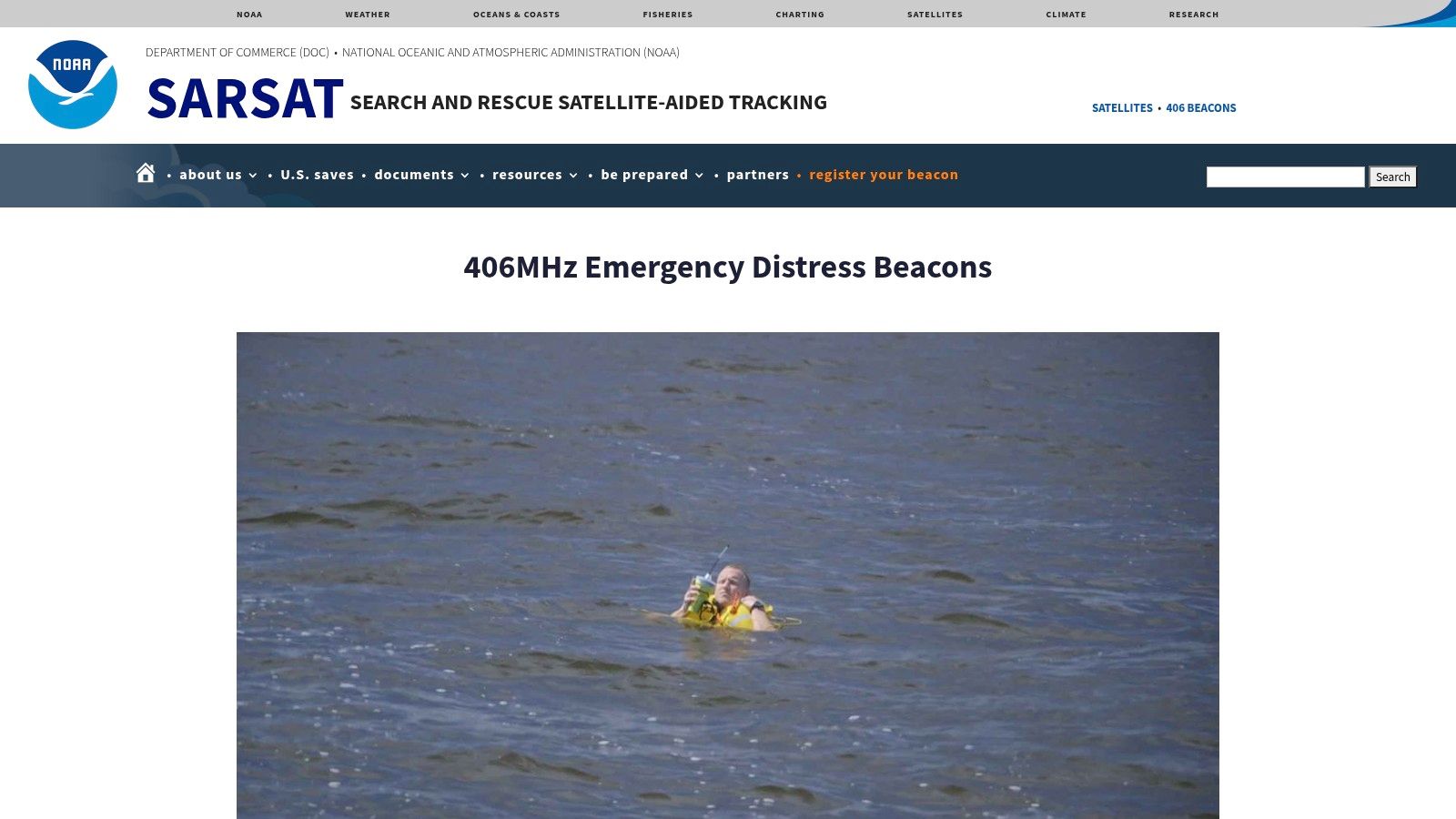
An EPIRB (Emergency Position Indicating Radio Beacon) is arguably the most important safety device on your boat, especially for offshore sailing. It's a lifeline in a serious emergency, connecting you with professional rescuers when you need them most. Unlike a VHF radio, which has limited range, an EPIRB uses satellites to alert rescue authorities worldwide. This makes it essential for both recreational boaters and professional captains.
When activated, an EPIRB sends a coded signal to the COSPAS-SARSAT satellite system. This signal contains your vessel’s registered information. If your EPIRB is GPS-enabled, it will also transmit your precise location. This information is then sent to the closest search and rescue authorities. This drastically reduces response time and increases your chances of survival.
Features and Benefits
-
Global Coverage: EPIRBs function anywhere on the planet, ensuring help is available even in the most remote areas.
-
GPS Precision: GPS-enabled EPIRBs pinpoint your location, reducing search time and maximizing rescue effectiveness. This is especially vital in the vastness of the open ocean.
-
Direct Alerting: The signal goes directly to search and rescue services, ensuring the fastest possible response.
-
Durable Design: Built to withstand harsh marine conditions, EPIRBs are waterproof, buoyant, and rugged.
-
Long Battery Life: Once activated, EPIRBs have a battery life of 24-48 hours, giving rescuers ample time to reach you.
Pros and Cons of EPIRBs
Here’s a quick overview of the advantages and disadvantages:
| Pros | Cons |
|---|---|
| Works worldwide | Higher initial cost ($200-$1500+) depending on type and features |
| No subscription fees for basic use | Requires registration with national authorities (e.g., NOAA in the US) |
| Alerts professional rescuers directly | Periodic battery replacement (every 5-10 years) |
| GPS models pinpoint location | Accidental activation can result in fines and divert resources |
| Non-GPS models rely on Doppler shift, resulting in a larger search area |
Category I vs. Category II
Category I EPIRBs are designed for automatic deployment and activation upon submersion. This makes them well-suited for larger vessels or situations where you might need to abandon ship quickly. Category II EPIRBs require manual activation. They are a more affordable option for smaller boats closer to shore. However, manual activation can be difficult in a stressful emergency.
Implementation and Setup Tips
-
Register Your EPIRB: Registration links the device to your vessel and provides rescuers with essential contact information. Update your registration whenever your vessel or contact details change.
-
Mount in an Accessible Location: Ensure your EPIRB is easy to reach but secured to prevent accidental activation. A quick-release bracket is ideal.
-
Familiarize Yourself with the Operation: Understand how to activate your specific EPIRB model. Practice in a safe environment to ensure you know what to do in an emergency.
-
Regular Inspection and Maintenance: Check the battery expiry date and the unit's overall condition. Replace batteries according to the manufacturer’s recommendations.
EPIRBs vs. PLBs
While similar, Personal Locator Beacons (PLBs) are for individual use, while EPIRBs are registered to a vessel. PLBs are smaller, more portable, and less expensive, making them a good supplemental safety device for crew members. However, an EPIRB is the preferred signaling device for emergencies involving the entire vessel.
For more information on EPIRBs and registration, visit the NOAA SARSAT website.
An EPIRB is an investment in your safety and peace of mind. While other safety gear helps manage emergencies, an EPIRB offers the ultimate assurance of rescue in a life-threatening situation. This makes it a vital piece of equipment for any boat venturing beyond nearshore waters.
7. Fire Extinguishers (Marine-Rated)
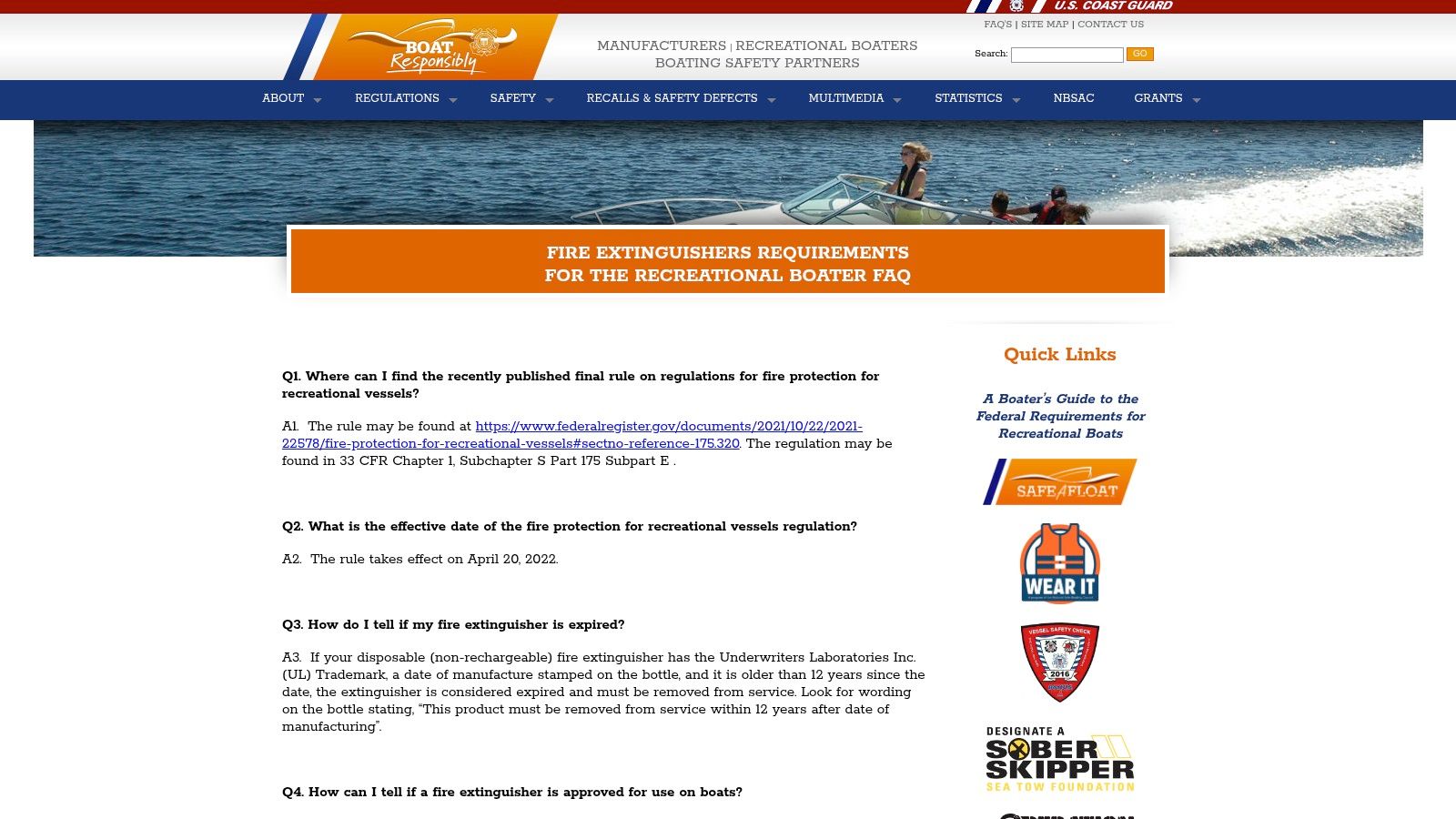
A fire on a boat can be a serious emergency. It's vital to have the right equipment to handle this dangerous situation. The U.S. Coast Guard requires marine-rated fire extinguishers on most vessels. These extinguishers are an essential part of boat safety.
Unlike regular fire extinguishers, marine-rated ones are designed for boat fires. They can handle fires fueled by gasoline, oil, and electrical problems. They're also made with corrosion-resistant materials to withstand the harsh sea environment.
Marine-rated fire extinguishers come in different sizes. These include 5-B, 10-B, and 20-B sizes. The right size depends on the boat's length and setup, such as if it has built-in fuel tanks or an enclosed engine area. The Coast Guard has specific requirements based on these factors.
Understanding Fire Extinguisher Ratings
These extinguishers use special agents to put out flammable liquid fires (Class B fires). They often have a B-I or B-II rating. The "B" shows it's good for flammable liquids. The Roman numerals tell you the size and how much it can extinguish. A 5-B works for smaller boats, while bigger boats need 10-B or 20-B extinguishers. Most also have a "C" rating, meaning they're suitable for electrical fires. This makes them very useful on a boat.
Features and Benefits of Marine-Rated Fire Extinguishers
- Marine-rated: Made for the corrosive marine environment and boat fires.
- Effective against flammable liquids and electrical fires: Great for gasoline, oil, and electrical fires.
- Corrosion-resistant: Built to last in saltwater.
- Variety of sizes: Meets Coast Guard rules for different boat sizes.
- Mounting brackets: Keeps them secure and easy to reach.
Pros of Having Marine-Rated Fire Extinguishers
- Essential for early fire suppression: Put out small fires fast before they get bigger.
- Compact and portable: Smaller sizes fit easily on smaller boats.
- No external power required: Works even if the electrical system fails.
- Potentially life-saving: Prevents serious damage, injuries, or even death.
Cons of Marine-Rated Fire Extinguishers
- Regular inspection and maintenance required: Check pressure and corrosion regularly.
- Limited discharge time: Only lasts 8-10 seconds, so you need to act quickly.
- Require replacement after use: Needs replacing or refilling after use, even if partly used. Replace also if the pressure gauge shows it's undercharged.
- Different classes for different fires: While good for Class B and C fires, other fires (like galley fires) may need a different type.
Check out our article about Sitemaps.
Implementation Tips for Fire Extinguishers
- Mount in easy-to-reach spots, away from the engine and galley.
- Make sure everyone on board knows where they are and how to use them.
- Check the pressure gauge often and replace or refill as needed. Follow the instructions.
- Practice using a discharged extinguisher in a safe place to get familiar with it.
For more information and specific rules, check the U.S. Coast Guard's website.
Having the right marine-rated fire extinguishers isn't just the law; it's essential for safety. They can protect your boat, passengers, and you. Investing in the right fire extinguishers is a small price to pay for preventing a disaster.
7-Point Boating Safety Equipment Comparison
| Product | Key Features ★ | Value Proposition 💰 | Target Audience 👥 & Unique Points ✨ |
|---|---|---|---|
| 🏆 CLiX Fueling Solutions | Automatic shut-off; USA-made; Diesel/Gas options | Spill-free fueling; Protects equipment & environment | Recreational & professional boaters; Endorsed for ease & safety |
| USCG Approved PFDs | USCG-approved; Multiple sizes/types; Reflective, inflatable options | Life-saving gear; Enhanced comfort & safety | Families, recreational & offshore boaters; Reliable, size-specific design |
| Marine VHF Radio | Waterproof; DSC & weather channels; GPS connectivity | Reliable emergency communication; Real-time updates | Boaters needing continuous comms; Multi-channel clarity |
| Visual Distress Signals | Day/night flares; Electronic reusability; Waterproof storage | Critical signaling in emergencies; Long-lasting e-flare options | Mariners needing quick alerts; Compliant with safety regulations |
| Automatic Identification System (AIS) | Real-time vessel tracking; Collision warnings; Chart integration | Enhanced situational awareness; Collision avoidance | Commercial & recreational boaters; Advanced navigational aid |
| EPIRB | GPS-enabled; Satellite communication; Auto/manual activation | Global rescue alerts; No subscription fees; Precise location | All boaters; Fast, globally recognized distress signaling |
| Marine-Rated Fire Extinguishers | Coast Guard approved; Corrosion-resistant; Secure mounting | Essential fire protection; Prevents catastrophic damage | Boat owners & marina operators; Compact yet effective design |
Smooth Sailing Ahead: Ensuring Safe and Enjoyable Boating Experiences
Having covered seven essential pieces of boating safety equipment, let's discuss making informed choices and using these tools effectively. When selecting items like Personal Flotation Devices (PFDs), consider factors like size, fit, and the type of boating activity you'll be doing. For electronics such as VHF radios and AIS transponders, research features, range, and ease of use. AIS transponders are automatic tracking systems. For visual distress signals, understand the regulations in your boating area regarding traditional flares versus electronic flares.
Getting started with some of this equipment might require a bit of research. Familiarize yourself with how your VHF radio works and practice using it before you're out on the water. Learn the proper way to deploy flares and understand the different types of fire extinguishers and when to use them. Regularly inspect your safety equipment to make sure it's in good working order.
Budget is always a factor. Prioritize essential safety gear like PFDs and fire extinguishers first. Then, consider adding tools like AIS and EPIRBs (Emergency Position Indicating Radio Beacons) as your budget allows. Look for reputable brands known for quality and durability. Remember, peace of mind is invaluable when it comes to boating safety.
Integration and compatibility are also important. Make sure your chosen equipment works well together. For instance, a VHF radio with built-in GPS can be very helpful in an emergency. Think about how each piece of equipment fits into your overall safety plan and how they work together.
Key Takeaways
-
Prioritize Safety: Safety equipment isn’t just about following the rules; it's about protecting lives and the environment.
-
Regular Inspection: Regularly check your equipment’s condition and expiration dates.
-
Informed Choices: Research and choose the right tools for your specific boating activities.
-
Practice and Preparation: Become familiar with how to use all of your safety equipment.
Ready to improve your boating safety and eliminate the hassle of fueling? CLiX Fueling Solutions offers a spill-free, worry-free way to fill your tank, protecting your boat, the environment, and your peace of mind. Experience the difference CLiX can make. Learn more and order yours today at CLiX Fueling.












